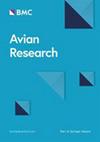Inter- and intraspecific variation in flight muscle fibers is associated with migratory timing
IF 1.7
2区 生物学
Q1 ORNITHOLOGY
引用次数: 0
Abstract
The life-history strategies of organisms are shaped by trade-offs among traits that influence survival, development, reproduction, and ultimately fitness. However, the specific physiological and environmental mechanisms driving population-level variation in phenotypic traits, particularly in relation to migratory adaptations, remain poorly understood. Elevational migration represents an adaptive behavior for mountain birds that offers a unique model to investigate adaptive phenotypes because of the diverse migratory strategies that have been observed within and between species. Flight muscles, as multifunctional organs, exhibit phenotypic variation that aligns with locomotor and thermoregulatory demands. Linking flight muscle phenotypes to migratory strategies can provide insights into inter- and intraspecific variation in migratory adaptations. In this study, we examined spring arrival dates at high-altitude breeding sites for three closely related high-altitude breeding birds in the mountains of Asia: Blue-fronted Redstart (Phoenicurus frontalis), Himalayan Bluetail (Tarsiger rufilatus), and Rufous-gorgeted Flycatcher (Ficedula strophiata). We analyzed relationships between arrival dates and phenotypic traits, including flight muscle physiology, morphology, and internal organ mass, alongside environmental effects on these traits. Our findings indicate that species arriving earlier encountered lower temperatures and exhibited reduced fiber cross-sectional areas coupled with higher fast oxidative glycolytic (FOG) fibers densities. Males displayed pronounced protandry and higher fast glycolytic (FG) fibers densities. Ambient temperature significantly influenced flight muscle phenotypes, highlighting intraspecific variation and the potential plasticity of flight muscle fibers as crucial mechanisms for adapting to migration strategies and environmental conditions. Additionally, this study underscores the potential role of sexual selection in shaping functional phenotypic variation, further advancing our understanding of adaptive strategies in high-altitude migratory birds.
飞行肌纤维的种间和种内变异与迁徙时间有关
生物体的生活史策略是由影响生存、发育、繁殖和最终适应的特征之间的权衡决定的。然而,特定的生理和环境机制驱动表型性状在种群水平上的变化,特别是与迁徙适应有关,仍然知之甚少。海拔迁徙代表了山地鸟类的一种适应性行为,由于在物种内部和物种之间观察到不同的迁徙策略,它为研究适应性表型提供了一个独特的模型。飞行肌肉作为多功能器官,表现出与运动和体温调节需求一致的表型变异。将飞行肌表型与迁徙策略联系起来可以为迁徙适应的种间和种内变异提供见解。在这项研究中,我们研究了亚洲山区三种近亲高海拔繁殖鸟类:蓝额红鸲(Phoenicurus frontalis)、喜马拉雅蓝尾鸲(Tarsiger rufilatus)和红峡捕蝇鸟(Ficedula strophiata)在高海拔繁殖地的春季到达日期。我们分析了到达日期与表型性状之间的关系,包括飞行肌生理学、形态学和内部器官质量,以及环境对这些性状的影响。我们的研究结果表明,到达较早的物种遇到较低的温度,纤维横截面积减少,纤维密度较高。雄性表现出明显的原雄性和较高的快速糖酵解(FG)纤维密度。环境温度显著影响飞行肌肉表型,突出了种内变异和飞行肌肉纤维的潜在可塑性,这是适应迁徙策略和环境条件的关键机制。此外,本研究强调了性选择在塑造功能性表型变异中的潜在作用,进一步促进了我们对高海拔候鸟适应策略的理解。
本文章由计算机程序翻译,如有差异,请以英文原文为准。
求助全文
约1分钟内获得全文
求助全文
来源期刊

Avian Research
ORNITHOLOGY-
CiteScore
2.90
自引率
16.70%
发文量
456
审稿时长
46 days
期刊介绍:
Avian Research is an open access, peer-reviewed journal publishing high quality research and review articles on all aspects of ornithology from all over the world. It aims to report the latest and most significant progress in ornithology and to encourage exchange of ideas among international ornithologists. As an open access journal, Avian Research provides a unique opportunity to publish high quality contents that will be internationally accessible to any reader at no cost.
 求助内容:
求助内容: 应助结果提醒方式:
应助结果提醒方式:


